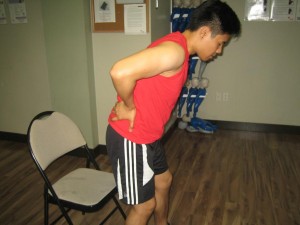The hip joint is comprised of large bones that function as anchors to several muscles. Once injury or overuse stretches or tears the muscle fibers, it results to hip strains. These strains typically occur in the hip area once a stretched muscle is forced to abruptly contract. Hip strains can be caused by overstretching, overuse, a fall or a direct blow to the muscle.
The risk for strains is higher if an individual had a previous injury and if proper warm up is not performed before exercise. The strains are categorized as mild, moderate and severe and it depends on the extent of damage.

Symptoms of a strained hip
- Pain on the damaged muscle
- Pain worsens if muscle is used
- Swelling is usually present depending on the extent of the strain
- Diminished strength in the affected muscle
How a hip strain is diagnosed
The doctor will ask about the activities before the onset of pain. The individual is also instructed to perform certain exercises or stretching to determine which muscle is damaged. An X-ray is also carried out to determine if there is a stress fracture in the hip. In most cases, additional tests are no longer needed to confirm a diagnosis.
Treatment for hip strain
Generally, the treatment and rehabilitation for a hip strain aims to minimize pain, restore the range of motion and strength.
The standard first aid treatment utilized is the RICE method for both mild and moderate strains.
- Rest and do not put weight on the hip. Crutches might be recommended for 1-2 days after the injury.
- Ice the area and gently massage to minimize the swelling.
- Compress the affected area using a wrap bandage or compression shorts.
- Elevate the affected area.
The doctor will also recommend pain medications to minimize the pain and swelling. After the initial days after the injury, heat therapy should be applied such as heat lamps, hot soaks or heating pads.
It is important to avoid activity that can strain the muscles for 10-14 days. During that period, it is ideal to restore muscle strength and endurance by performing strengthening and stretching exercises. In case the pain returns, stop and minimize the activity level. Take note that cases of severe muscle strains would require an extensive rehabilitation time.
[youtube url=”http://www.youtube.com/watch?v=BVkVC2LOhXQ” width=”400″ height=”220″]How to prevent hip strain
There are various ways to avoid straining the muscles surrounding the hip. Primarily, always stretch properly before performing your exercise. The muscles should be stretched in a slow manner and hold the stretch. Other ways to lessen the risk for hip strain includes:
- Always warm up before stretching so that stretching is more effective
- Take part in a conditioning program for flexibility and muscle fitness
- Use appropriate protective gear when engaging in sports
Hip strains can be easily prevented with the following measures. This is the reason why warm up is always important before engaging in any exercise routine.